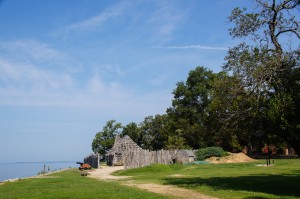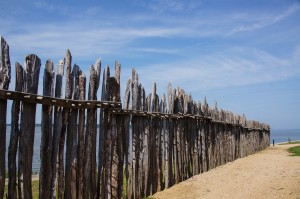14.08.2012 – 14.08.2012 ![]() 30 °C
30 °C
Early start this morning with us leaving Williamsburg for the Shenandoah Valley. Our first stop this morning was to see the site of the very first real settlement in the USA at Jamestown, Virginia (I mean real because from this settlement the entire country was colonised—unlike the Lost Colony of Roanoke). Jamestown was first settled in May 1607 by a hundred or so men from the Virginia Company of London. They were here in the New World primarily to build a community from which people could start to look for gold. Obviously, the gold side of the endeavour failed miserably, and did not prove profitable til the mid 1800s with the California gold rush.
 Today, not much remains of the first settlement at Jamestown but a few ruins. It is an ongoing archaeological excavation which to date has found the remains of the first church, graveyard, shops and the palisade. As we were walking around the site, our guide told us about the first major settlement thanks largely to diaries from the first governor John Smith. The settlers were given the mandate to create a permanent colony on lands not currently habituated, that had easy access to fresh water and were good for farming.
Today, not much remains of the first settlement at Jamestown but a few ruins. It is an ongoing archaeological excavation which to date has found the remains of the first church, graveyard, shops and the palisade. As we were walking around the site, our guide told us about the first major settlement thanks largely to diaries from the first governor John Smith. The settlers were given the mandate to create a permanent colony on lands not currently habituated, that had easy access to fresh water and were good for farming.
Sadly, the location of Jamestown doesn’t fit any of the above criteria except that it wasn’t habituated. The Indian’s didn’t live on this land for a few reasons- it didn’t have ready access to fresh water, it wasn’t a good area for farming and it was their hunting grounds. The English did try to scout other areas for their first town but not too surprisingly all of the good places to live were already taken by Indian tribes.
 The local Indian tribes were actually very good to the first settlers. They traded swords, muskets, clothing and household goods for food. For the first year or so relations were excellent between the two but gradually issues began to arise- the Indian’s started to die from unknown diseases, they resented their loss of hunting grounds and food supplies started to reduce (because of the trading with the British). The British also started to get sick from drinking salty water and from a poor diet as the crops struggled to grow and because even trading with the Indians there wasn’t enough food to go around. These problems grew until eventually the Indian’s surrounded the British stockade and tried to starve the British out. This was almost successful; the settlers were even reduced to cannibalisation to try and survive the winter. Just as they thought all hope was lost another English ship arrived with provisions and more settlers.
The local Indian tribes were actually very good to the first settlers. They traded swords, muskets, clothing and household goods for food. For the first year or so relations were excellent between the two but gradually issues began to arise- the Indian’s started to die from unknown diseases, they resented their loss of hunting grounds and food supplies started to reduce (because of the trading with the British). The British also started to get sick from drinking salty water and from a poor diet as the crops struggled to grow and because even trading with the Indians there wasn’t enough food to go around. These problems grew until eventually the Indian’s surrounded the British stockade and tried to starve the British out. This was almost successful; the settlers were even reduced to cannibalisation to try and survive the winter. Just as they thought all hope was lost another English ship arrived with provisions and more settlers.
Jamestown is also where the famous story of Pocahontas is played out. According to Disney Pocahontas fell in love with Adam Smith and married him. In reality she was only about 12 years old when the settlers first arrived and was seen as a peace offering. This is because whenever the Indian chief would visit the enclave he would bring his daughter with him. The settlers knew that the chief wouldn’t bring his daughter if he was going to make war on the settlers. Pocahontas did grow up to marry one of the settlers (John Rolfe) and convert to Christianity, probably more because she had to than she wanted too!
We left Jamestown just before lunch time after checking out the archaeological dig (currently they are excavating the graveyard and a store house) and the small museum. From Jamestown we drove almost due west on the Jamestown river road because this is the road that some of the oldest plantations are located. The first plantation house was built in 1613 and is still sort of standing (well parts of the original building are still visible—foundations for example)! We stopped in to take a look at one of the plantations but it really didn’t rival the style we had seen down in Louisiana so I was a little disappointed and after a couple of photos we continued north west towards Shenandoah.
We continued to drive for the remainder of the day. The further west we got the greener the countryside and the more rolling the hills became. Most of the land out here is under cultivation, mainly beef cows and horses. Its actually really refreshing to see something other than corn being grown! Not only are there some really green looking paddocks there are some really scrummy houses back off the road… I’m guessing the local’s around here aren’t the Hill Billy type of Virginian that we hear about! I think they are more the wealthy southerners of old!!
Around 5pm we started hunting for somewhere to spend the evening. First town we came to Madison had no options! I was a little surprised as the town seemed to be large (based on the font size from the map book)… not so! 1 main street and no accommodation options… Ok so we continued driving up north a bit and eventually found ourselves somewhere to bunk for the evening at Culpeper. Phew! It’s the only issue with travelling without a plan, sometimes (although not yet on our trip) you can run into some complications!!!
Song of the Day– Rihanna, Shut up and drive
